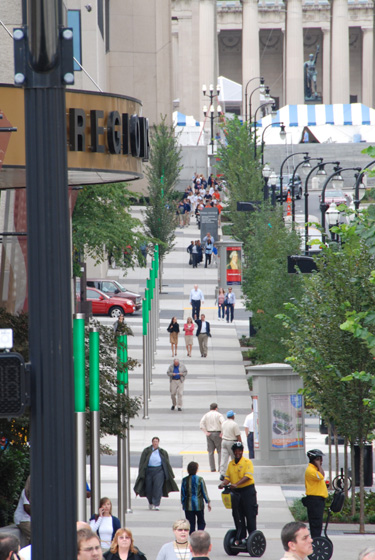 Photo Source: ASLA
Photo Source: ASLA
It has been three years since the American Society of Landscape Architects (ASLA) finished the 3,000sf green roof on top of the their headquarters building in Washington D.C. The green roof is unusual in that it is sloped to cover the mechanical units on the roof. An informative video (link to video) was posted on Youtube this month highlighting the stormwater benefits of the ASLA roof. Nancy Somerville, ASLA’s CEO was interviewed during the video and she stressed the important role green roofs could play in helping address Washington D.C.’s and the nation’s difficult stormwater issues (i.e. water pollution, Combined Sewer Overflows). An EPA report estimated 850 billion gallons of untreated sewage and stormwater are discharged nationally each year as combined sewer overflows. (EPA Fact Sheet [pdf]) As Ms. Somerville points out, green roofs can filter the stormwater falling on the roof as well as act as a sponge and significantly reduce the amount of stormwater coming off of the roof. A green roof with 4″ deep planting media has been shown to retain 63% of the rain fall hitting the roof.
During the first year, ASLA conducted a study (link to ASLA green roof website) to quantify the specific benefits of the their green roof. The data showed that 74% of the water was retained on the roof. Interestingly, the water quality of the stormwater discharge leaving the roof included an increase in pH and temperature as compared to the rain fall. In addition, the test results showed a significant increase over the concentration originally present in rain water for Chemical Oxygen Demand (COD), phosphate, total phosphorus, total suspended solids, and total dissolved solids. According to the report most of these contaminants were within the allowed freshwater chronic concentration values established by the E.P.A. and none of the concentrations were above the acute level. Unfortunately, the study did not compare the green roof with a conventional roof. The report concluded that “Green roofs have significant potential for reducing stormwater carried pollutants in major metropolitan areas such as Washington DC. However, more comprehensive and extensive monitoring studies are needed to evaluate specific performance measures of specific designs and develop accurate predictive tools.” The following are a few specific findings highlighted in their press release (.doc):
- The roof typically retained 100 percent of a one-inch rainfall.
- The heaviest rainfall during the monitored period was March 16, 2007. A total of 2.48 inches of rain fell during the 24-hour period with the roof retaining 51 percent, the equivalent of 1.3 inches of rain.
- The green roof did not add any nitrogen to the runoff. Because of the amount of water retained, the roof provided a significant reduction in the amount of nitrogen introduced back into the watershed.
- Typical of “young” green roofs, the analysis showed higher amounts of some other nutrients such as phosphorus, as well as heavy metals in the runoff—all below EPA standards and below levels expected from street runoff. Based on other green roof research, nutrient levels are expected to decrease in a few years. The heavy metals may be coming from the roof materials or from settled particulate matter/pollutants.
- It is important to note that this study did not look at runoff from a conventional roof compared to the green roof runoff—and the results would be expected to look different. Water quality testing will be repeated in two years to see how the results change over time with a goal of comparing the green roof runoff to conventional roof runoff.
- The green roof has been as much as 32 degrees cooler than conventional black roofs on neighboring buildings.
- Engineering analysis showed that the green roof created a 10 percent reduction in building energy use during winter months and negligible difference in the summer.
On a city wide level, the Casey Tree, a non-profit dedicated to restoring, enhancing and protecting the tree canopy of the Nation’s Capital, conducted a study (link to study) of the Washington D.C. area that examined the impact of green roofs and tree plantings. They concluded that if 55 million square feet of green roofs were installed throughout the Washington D.C. area, they would reduce the reduce CSO discharges by 435 million gallons or 19% each year.
These studies illustrate the effectiveness of including green infrastructure within the overall strategy for cleaning up our nation’s stormwater.
-Brian Phelps












You must be logged in to post a comment.